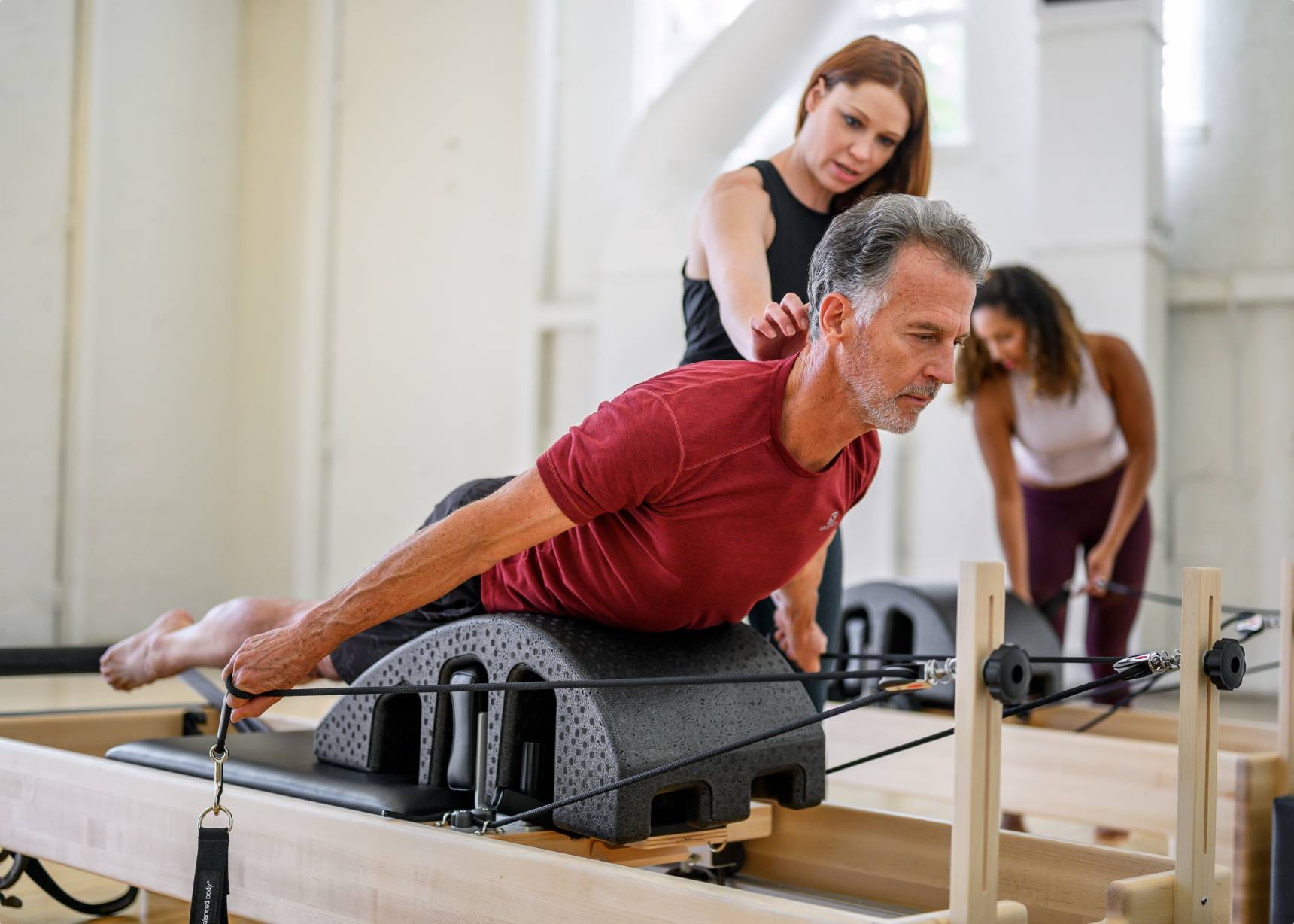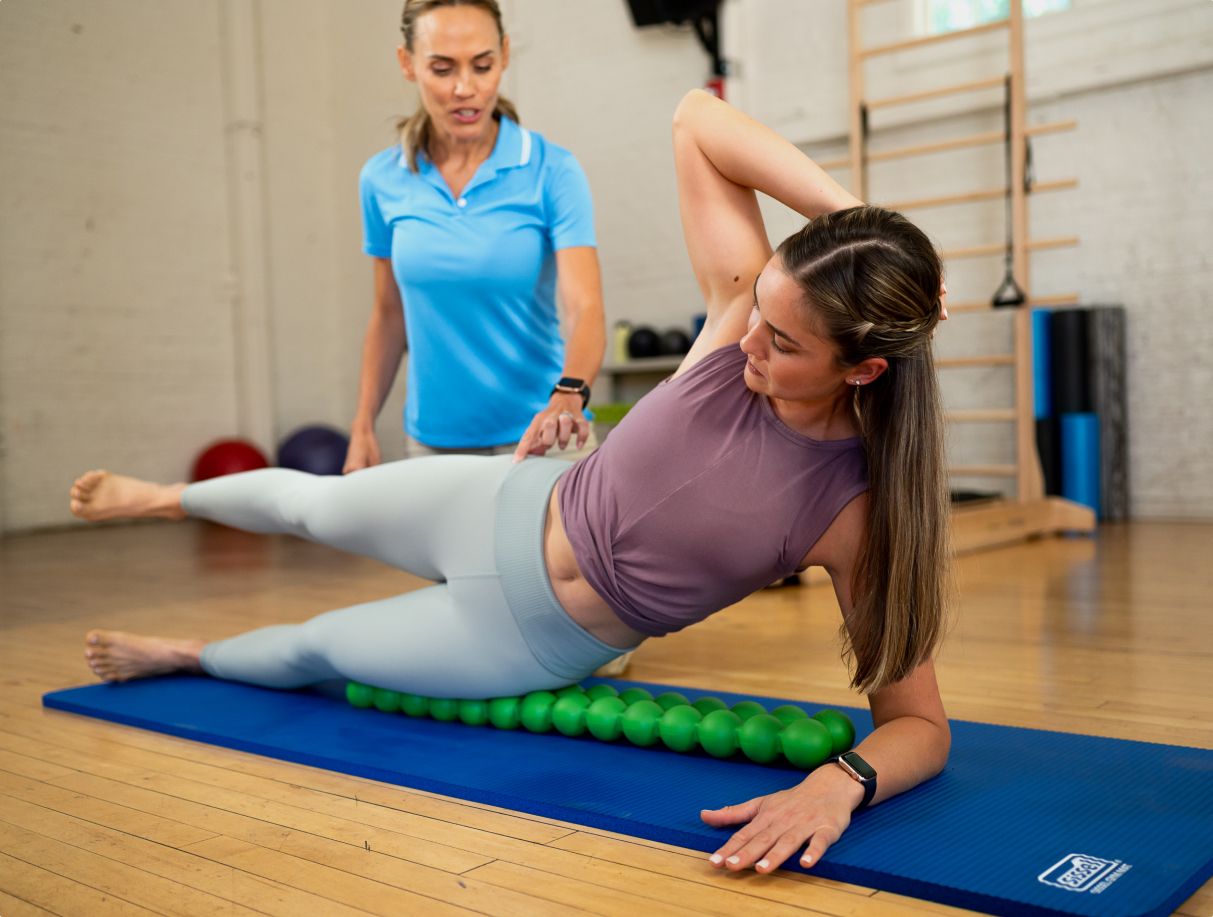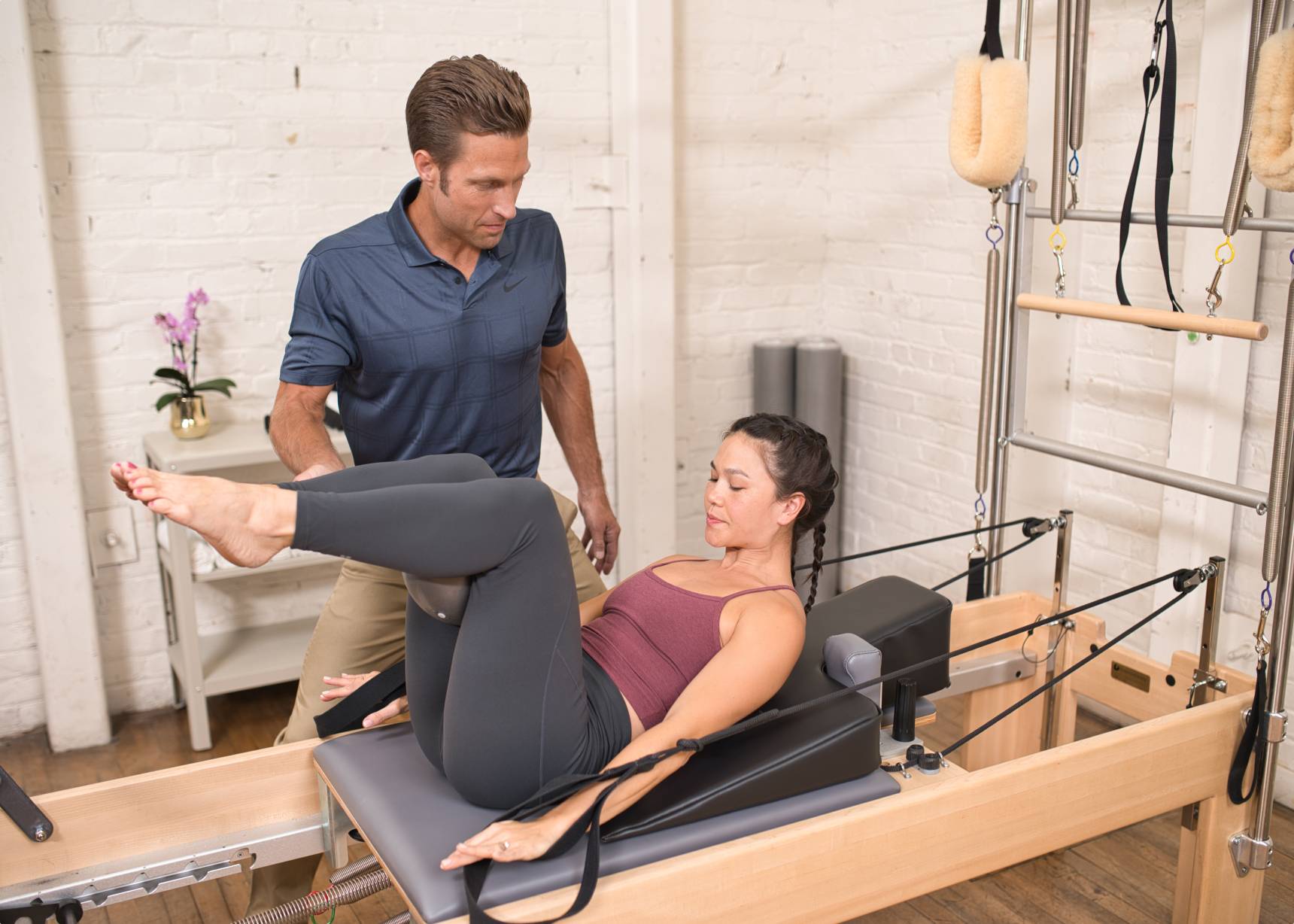Pilates for People with Parkinson’s Disease
Pilates for People with Parkinson’s Disease
By Lindy Royer and Kriste Waldmann
According to the National Parkinson Foundation, Parkinson’s disease (PD) is the most common neurodegenerative disease after Alzheimer’s. PD affects both men and women in almost equal numbers. It shows no social, ethnic, economic, or geographic boundaries. In the United States, it is estimated that 60,000 new cases are diagnosed each year, joining the 1.5 million Americans who currently have PD. While the condition usually develops after the age of 65, fifteen percent of those diagnosed are under 50.
PD is a chronic, progressive disease that results when nerve cells that produce dopamine die or are impaired. Dopamine is a chemical messenger that transmits signals from the substantia nigra to another part of the brain called the corpus striatum, controlling coordinated movement. When these cells die, the other movement control centers in the brain become unregulated.
These disturbances cause the symptoms of PD. Initially, the physical symptoms are mild, usually on one side of the body, and may not require medical treatment.
Signs of Parkinson’s Disease
The primary signs of Parkinson’s disease are:
- Resting tremor of a limb (shaking with the limb at rest)
- Slowness of movement (bradykinesia)
- Rigidity (stiffness, increased resistance to passive movement) of limbs or trunk
- Poor balance and coordination (postural instability)
Other signs of PD may include:
- Small, cramped handwriting
- Stiff facial expression
- Shuffling walk
- Muffled speech
- Depression
Treating Parkinson’s Disease
Current treatment approaches for Parkinson’s Disease include medication, surgical procedures, and nutritional, physical, occupational, and speech therapies. Many patients also seek complementary therapies such as acupuncture, massage, or hypnotherapy.
Medication
Many medications are currently available for treating the signs and symptoms of PD, but none have yet been proven to slow or stop the progression of PD. There is hope that a medication will soon be developed, which proves itself as a true neuroprotective agent capable of stopping, slowing, or reversing the effects of PD. Since each person with Parkinson’s has such individualized symptoms, the goal of medication is to reduce specific symptoms. This is usually accomplished with a combination of drugs, depending on the patient’s tolerance.
Most PD medications work by influencing dopamine, and these drugs can produce several side effects such as nausea, low blood pressure, dyskinesias (writhing movements), and hallucinations. The primary symptoms of PD can all be reduced with medication, but the disease is progressive and many patients will require more medication as time passes.
Surgery
Surgical procedures have been used for the past fifty years. The latest surgical approach is deep brain stimulation (DBS), a technique developed in the 1990s and approved by the FDA in 1997. This approach is especially effective for PD patients with disabling tremors, wearing-off spells (which occur when individual doses of a patient’s antiparkinson medication lose their long-term effect), and dyskinesias. DBS involves inserting electrodes into a target area of the brain, determined by the patient’s symptoms, and implanting a device under the collarbone. The device provides continuous current to affect motor function. DBS does not help improve balance or gait freezing and is only minimally effective on speech and posture. Other surgical procedures include thalamotomy and pallidotomy, both of which involve the destruction of small amounts of tissue in the thalamus and globus pallidus, respectively.
Therapy
Therapies such as nutritional support, speech therapy, and occupational therapy can all help improve a patient’s quality of life and decrease the daily challenges experienced by Parkinson’s patients. Physical therapy in particular has been shown to improve mobility and coordination. According to a study published in the Journal of the American Geriatrics Society (1998; 46:1207-1216), ten weeks of a coordination and flexibility-based exercise program, three times per week, was shown to have significant measurable improvement in mobility and coordination compared to control subjects. Numerous research studies indicate improvement in gait, motor function, and activities of daily living.
It is worth mentioning that an ongoing, consistent rehabilitation program seems to be of significance in treating the symptoms of Parkinson’s disease. According to a study published by the Academy of Neurology, once a rehabilitation program is stopped, the improvement is not sustained. (Neurology 1994; 44:376)

Benefits of Pilates for Parkinson’s Patients
Since all treatment options can only slow the progression of symptoms, keeping physically active is integral to living at one’s potential. The saying “use it or lose it” applies here. And since there is the obvious “mind-body” connection governing the symptoms of PD, the comprehensive Pilates method can offer the optimal environment to maintain neuromuscular movement potential.
To achieve the highest accomplishments within the scope of our capabilities in all walks of like, we must constantly strive to acquire strong, healthy bodies and develop our minds to the limit of our ability.
—Joseph Pilates, Return to Life
An Experienced Pilates Instructor is Critical
As with all special needs, it is preferable to find a Pilates instructor who has post-rehabilitation experience, works under the guidance of a rehabilitation professional, or is a Pilates certified Physical Therapist.
A seasoned Pilates instructor who has comprehensive Pilates training/certification and has access to all Pilates apparatus (not just mat or Reformer) can fine-tune sessions to meet the varying needs of individual PD clients in a superior way because:
- Joseph Pilates designed each piece of equipment to create an assistive environment, to help facilitate a multitude of specific movement needs that vary between individuals.
- Since each person can have differing symptoms and symptom severity, sometimes changing weekly due to stress or other factors, the Pilates teacher needs the ability to modify on the spot, in order to optimize each session.
- The ability to bring a client from a foreign to a familiar environment/gravity relationship, and to simulate functional, biomechanically correct movement with increased proprioceptive challenge can best be achieved with access to multiple Pilates apparatus. For example: doing Footwork on the Reformer, progressing to a single-leg version, and then eventually to the Standing/Single Leg Pump on the Chair.
- The addition of Pilates mat repertoire and use of props such as foam rollers, balls, balance discs, etc, can be used (when successfully following this model of progression) to develop an individualized program specific to the patient’s activities and functional requirements. This also allows for a home exercise program to complement the studio program, especially for clients who are unable to commit to a studio appointment more than once a week.
- Access to a Ladder Barrel or at least a Spine Corrector can help facilitate needed spine articulation, especially through thoracic extension, rotation, and lateral flexion.

Kinesthetic cueing targets the neurological connection to movement education. Having the client focus on how a movement feels and how it relates to the body as a whole gives awareness tools to the client that can be used in daily activities outside the Pilates environment. For example, if the client compresses the spine and pelvis into a compensatory posture every time the hip is flexed, the goal of a hip-flexion exercise should be less about leg strength and more about efficient movement strategy. “Feel taller through your spine as the wheel in your hip joint turns. Can you imagine which direction your knee is pointing as it bends?” Also, using words like “ease” and “smooth(ly)” to describe desired movement can help reduce global muscle over-recruitment; as well as the “intention tremors” which can delay or stop an intended motion. Range and resistance may need to be adjusted until the client can gain awareness and successful movement without affecting posture.
Pilates Therapeutic Exercises for Parkinson’s Patients
Key repertoire to include in a Pilates Program for PD clients:
- Spine mobility exercises especially through extension, lateral flexion and rotation
- Scapular patterning prior to UE exercises and integrated with spine movement
- Hip mobility especially through extension, rotation, adduction and abduction, then integrated into gait
- Progressions to maximize the client’s balance and coordination abilities, and applications to daily activities or sport

Recommendations for Pilates Instructors
If ongoing private Pilates sessions are not financially or otherwise feasible, a general Pilates program including small classes and a home exercise program can always benefit a person with mild-symptom PD, but precautions must be observed:
- Always predetermine an individual’s ability of balance, especially if equipment will be used in session, and prepare for necessary assistance.
- Although one goal is to maintain as much joint and spine range of motion as possible, the teacher and client must explore individual ability and not force movement which can strain both physically and mentally, defeating the purpose.
- “Classical” Pilates repertoire tends to involve a lot of flexion (spine curling) exercises. Since the rigidity inherent with PD tends to bias the posture toward excess kyphosis, balancing a session with gentle extension, rotation and side-bending exercises is essential for enhanced spine mobility and posture.
Creating an inspiring environment and modifying Pilates repertoire as needed each session, is essential in order to provide a PD client the potential for successful movement. In addition to the physical maintenance benefit, Pilates can also help restore and maintain self-confidence, and a sense of well-being that has often waned after being diagnosed with Parkinson’s disease, which may be the most limiting, debilitating symptom of all.
About the Authors
Lindy Royer, P.T., CPT, is the director of Park Meadows Pilates and Physical Therapy in Lone Tree, Colorado and a licensed physical therapist with extensive experience in Sports Medicine and Rehabilitation. She was introduced to The Pilates Method in the late 1990s, completed her Polestar Pilates Certification in 2002, and now teaches Pilates certification courses for Polestar Pilates nationally. The integration of medical-level Pilates into Lindy’s Physical Therapy practice has had a significant impact on the level of successful recovery she sees in her patients.
Kriste Waldmann is the Lead Instructor for Park Meadows Pilates and Physical Therapy. Introduced to the Pilates method in 1993, she became a Pilates teacher the old fashioned way: years of apprenticing under a variety of talented teachers with backgrounds ranging from classical and evolved Pilates methods, physical therapy, dance, Feldenkraisâ, and sports & fitness. She earned her comprehensive Pilates certification though Polestar Pilates in 2001, and has mentored apprentice Pilates teachers since 2003. She is passionate about ensuring novice teachers embrace the scope of possibility and responsibility of whole-body/mind health for all through Pilates, and that there is endless knowledge to discover and grow from.
As seen in the Balanced Body Summer 2007 Pilates COREterly